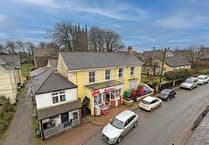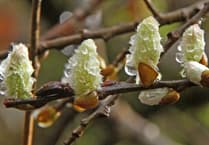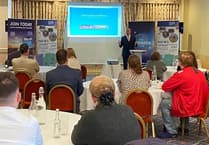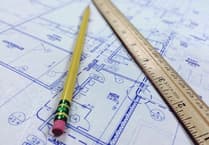MARKING 50 years since the train line through Launceston closed, members of the public joined the Launceston Railway Circle and special guests to celebrate the great history of the town’s line.
The event, held on Friday evening in Launceston Town Hall, saw around 200 people come from far and wide, unfortunately not by train, to hear the variety of talks and presentations to commemorate the 50th anniversary of the closure of the Launceston line.
Member of the Launceston Railway Circle, Les Whaley, said: ”We have had phone calls through the Post’s article from people in St Ives, Barnstaple, Exeter, Bridgwater, Plymouth and Tavistock, all checking times and details. We have had a lot of interest in this event.”
The evening provided those in attendance with a chance to find out more about the long history of Launceston and its relationship with the railway and included a variety of interesting and informative talks.
There were talks given by the chairman of the Launceston Railway Society, North Cornwall Conservative MP Scott Mann and special guest Lord Richard Faulkner of Worcester.
One of the highlights of the evening was the ‘All Stations Then and Now’ presentation given by Bernard Mills and Geoffrey Chegwidden in which they took the audience through a variety of photographs of areas along the Launceston to Okehampton line.
The evening was in danger of going off the rails at one point after a few minor technical difficulties, however, the team soon overcame these and got back on track.
Chairman of the Launceston Railway Circle, Andrew Bird, got proceedings underway with an introductory speech providing information about the Launceston railway line, which he said ‘was closed almost 50 years ago to the day of this event’.
Mr Bird explained that in 1865 the first railway arrived in Launceston during the summer and connected the town with Plymouth. A second connection to Okehampton was later established in 1886, which then extended on to Wadebridge and Padstow.
It became possible to catch a direct train to London from 1900 and by the end of the 19th century passengers were able to make their way to Bude and Holsworthy from Okehampton, via the Halwill junction.
This meant that if a passenger left London at 11am and travelled down what was known as the ‘Atlantic Coast Express’ they would arrive at Launceston railway station at about 4.05pm that afternoon.
Unfortunately by 1966 there were only four trains running per day between Okehampton and Launceston. The last train left Launceston station on October 3, 1966.
During his introductory talk Mr Bird gave an account of his family’s experience with the line. He said his parents had been planning to relocate their family farm down to the South West via the train. Having booked their tickets for mid October they were later informed that the line had been closed earlier that month, forcing the Birds to relocate via car instead.
Mr Bird ended his presentation with a cinefilm of his sister-in-law travelling on the second-to-last train.
During the film he said: “And there she is, obviously she had to have an ice cream.”
It gave a glimpse into what it was like to travel along the old Launceston line and the experiences others, like Mr Bird’s sister-in-law, had on the train. Those present were pleased to have been able to see footage of the last running days of the train as many who were present remembered the last day very well and had their own stories to tell.
During the evening one member of the audience, Francise Johnson, of St Giles, told the Post how she remembers her own trip on the last train to Launceston.
She said: “We travelled on the last train from Tower Hill station. Oh yes, I used to go on the train all the time. We used to live in Holsworthy but went to school in Bude so would travel on the line all the time. It was really criminal to lose the service to Bude.”
When asked about her trip on the last train, she said: “I remember getting on the train with my little girl and two little boys who were wearing their short trousers. It was lovely. I would like to see the train return.”
Local historian Arthur Wills, grew up surrounded by the railways. He told the Post about his experiences with the local Launceston line: “My father was up in the signal box. I was a bit of a ‘celebrity’ at school because of the things we got to see.
“We lived in the row of houses by the station and our neighbours were all workers for the line. You had Mr Bishop on one side, who was a guard, Tom Oak the railway driver, and the ticket officer lived on the end.”
He told the story of how he had ‘stood in the station managers’ gardens in order to see the Queen’ when she came to visit the station in 1956. He also explained how the station brought people together and saw the reunion of two service men.
“I remember when the circus train came into town. I was up in the signal box with my dad and saw the train come in — all the keepers were there with their animals.
“Well it turned out that my dad had served together with one of the men out in India, so they had a bit of a reunion at the train station.”
Also speaking in response to the cinefilm, Launceston Town Councillor Jane Nancarrow said: “I went out on the last train with my family. There was about a dozen of our family on board, mostly my mother’s side. We were very upset when they closed the line; it was such a sad day — there were tears.
“We lived on Tredydan Road and used to go down and wave at the passing train, it was like we were the real life railway children.
“I was taught by Charles Causley up at the National School and we used to take the train for school trips. I think it is ludicrous that the lines were closed.”
Following Mr Bird’s introduction Lord Faulkner was invited to take up the microphone and give a talk on the history of why the railways were closed.
He began by thanking Mr Bird for playing the cinefilm of the last running day of the train. He said: “What an amazing film that was, the before and after film — it was very moving.”
Lord Faulkner then spoke about the gaps in British rail policy, which followed the closure of the lines. He has already co-authored two books on the subject and was well versed in his field.
He said: “We need to go back to the 1950s, where the first serious programme of railway closures were already underway. Ernest Marples, the at-the-time transport minister, had appointed [Dr Richard] Beeching.
“Beeching’s main mission was to find the ‘holy grail’ — a profitable, unsubsidised railway. During his search bus replacement services were suggested and seeing how unpopular these bus replacements are I find it extraordinary that Great Western Railway campaigned for the closure of 40 regional lines in favour of a replacement bus service. Buses aren’t even a good question!”
Lord Faulkner explained that even after Dr Beeching had left, ‘his legacy was left behind’ and the railways continued to face more problems — as they do today.
Speaking to the Post after his presentation, Lord Faulkner said: “There was an inevitability about its closure. So much damage was done to the railway due to the shortsighted closures.
“Railways are now more popular than ever but in places like North Cornwall people are denied the opportunity.”
When asked if he thought there was a possibility for the railway lines to return to Launceston, Lord Faulkner said: “I never say never but I certainly wouldn’t write off a Bodmin to Wadebridge link re-opening.”
After a break for refreshments and a raffle, held by the Royal British Legion which raised £160, Bernard Mills and Geoffrey Chegwidden took up their places to give a very informative, and slightly improvised, pictorial talk entitled ‘All Stations Then and Now’.
With some difficulty they managed to display two images side-by-side showing some ‘before and after’ shots of the stations along the Launceston to Okehampton line, including Egloskerry, Camelford, Delabole, Launceston, Tresmeer and Wadebridge.
Mr Mills said: “The founder of the Launceston Railway Circle, Mr Lloyd Goodman, took the black and white pictures, they are from his collection. Me and Geoff went out and took the pictures of what they look like today. We had some trouble as a few of the stations go through private property, but we did the best we could.”
Technical difficulties meant the presentation was a little disjointed at the start, however the team soon managed to get the corresponding images on screen and Mr Mills quipped: “Well, we’ve arrived at Halwill by various means!”
Messrs Mills and Chegwidden continued to take the audiences through each of the stations and upon reaching an image of the old ‘Halwill for Beaworthy, junction for Bude, North Cornwall and Torrington lines’ Mr Mills said: “That’s got to be important hasn’t it. It sounds awfully grand.”
He concluded: “When you look at the buildings and the infrastructure it is hard to believe it could be wiped from the face of the earth — but it has been!”
The audience thanked them both for the enlightening and evocative presentation, which reminded many of the routes they had once been able to travel along when the line was still in service.
Mr Mann was then invited to speak on future plans for rail services. He said: “When we saw Dawlish washed into the sea it was obvious that we had to have a look into our railway networks. We can’t afford to have our railway washed into the sea — we were completely cut off.
“I’ve had two railway meetings this month and I have to say Launceston’s has just, and only just, outdone Bude’s. We have such enthusiasm here in North Cornwall for the railways.”
Speaking on what he will do to aid any future rail networks in the South West, Mr Mann said: “I think we need to look into having a short term and medium term plan and I will keep pestering the minister in the lobby as I think this is something we need again.”
Mayor of Launceston, Brian Hogan, concluded the evening with a few words: “I have to say it was lovely to see the images of the old stations. Everyone has memories of the railway, mine are of the steam trains.
“I remember mum and dad told us not to stick our heads out of the windows and, of course, that is exactly what we did! When we came back in we had blackened faces but I think that was all part of the fun.
“It was a shame what happened to the railways but there is a political will to bring the trains back to North Cornwall.
“Thank you gentlemen for an informative evening, which was injected with comedy. You have made a stalwart job of it all due to the technical difficulties you faced.”
This was met with a resounding agreement and applause from the audience.
If anyone is interested in joining the Launceston Railway Circle or wants to find out more information about future meetings, contact publicity officer Les Whaley on 01566 774622 or email [email protected]




